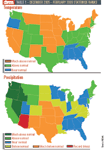Mild winter to unleash bigger parasite threat
Davis, Calif. - Ranking as the fifth-warmest winter on record for the United States, an expert entomologist warns it could signal a busy parasite season, thereby increasing the threat of vector-borne disease transmission.
DAVIS, CALIF. — Ranking as the fifth-warmest winter on record for the United States, an expert entomologist warns it could signal a busy parasite season, thereby increasing the threat of vector-borne disease transmission.
Heartworm, West Nile virus and various forms of encephalitides should be on the watch list, reports Dr. Gregory Lanzaro, medical entomologist and director of the Center for Vector-borne Diseases at the University of California-Davis. When a warm winter is coupled with high moisture, the conditions are perfect for burgeoning populations of certain mosquito species.
"Unfortunately, I think this is just one of those years in a lot of places in the United States. There is major concern in the Gulf Coast with all this water and the deterioration of the infrastructure for controlling these things," Lanzaro reports.

Table 1. and 2. - December 2005 - February 2006 statewide ranks
According to the National Oceanic and Atmospheric Administration (NOAA), the average temperature for the contiguous United States for December through February averaged 36.3-degrees F, which was 1.2 degrees F above the 1895-2005 mean. While U.S. precipitation totals were near average for the country, much of the West and Northwest were far wetter than the average. Drought conditions prevailed throughout much of the Southwest and central and southern plains. (See Tables 1 and 2.) Forty-one states posted above-normal temperatures this winter, NOAA says.
"Out here in California, we anticipate a pretty busy season with respect to mosquitoes and mosquito populations," Lanzaro adds. "In the Southeast, especially along the Gulf Coast, there are going to be problems as well.
"If we have a milder winter, the mortality is lower and that means we are going to have a larger number of mosquitoes emerging in the spring. That first generation that they produce is going to be larger, so we will get larger populations earlier."
These disease vectors overwinter in that mode. If adults survive, they are ready to start the transmission cycle when they break out of hibernation. Melting snow starts the cycle by flooding the eggs with water. Oxygen in the water is reduced due to microbial growth, which in turn stimulates the eggs to hatch, Lanzaro explains.
Many of the mosquito-vectored diseases are also transmitted from an infective female to her eggs. Those progeny will be infective when they emerge. They will be capable of transmitting on their very first bite," he says.
"It happens with West Nile, but we are still not sure exactly how efficient that is, how much the virus ultimately goes from the female mosquito to her eggs." His message for Californians: The Culex mosquito is on the prowl earlier this year. According to CDC reports, the disease infected 2,949 people, 116 of whom died.
He counsels veterinarians to remind clients to eliminate sources of standing water. Anything that can hold water for more than a few days can become a breeding site.
Lanzaro says the approximately 850 species of ticks worldwide are a lot heartier at surviving a tough winter. Tick survival is more regulated by host populations, and these parasites typically have a two-year life cycle.
Most fleas overwinter in the larval or pupal stage with survival and growth best during warm, moist winters and spring. Adult fleas cannot survive or lay eggs without a blood meal, but they can live from two months to one year without feeding.
And for fleas, the nuisance and disease transmission capabilities are well documented. The Southwest remains on surveillance for a plague.